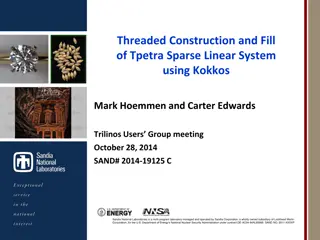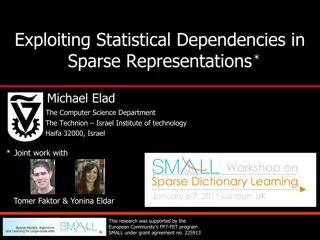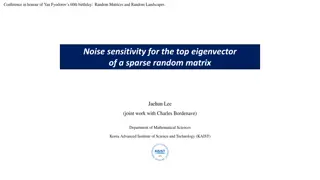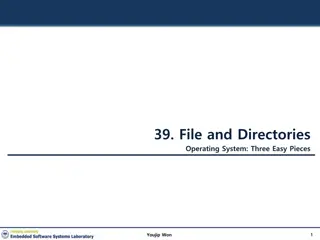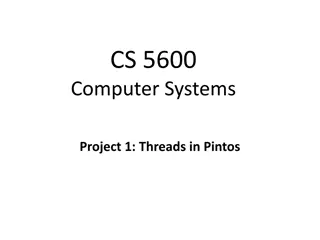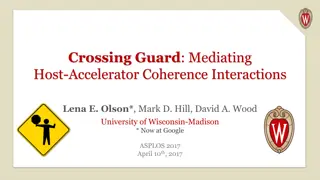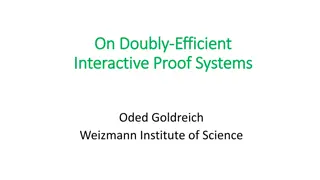Efficient Coherence Tracking in Many-core Systems Using Sparse Directories
This research focuses on utilizing tiny, sparse directories for efficient coherence tracking in many-core systems. By optimizing directory entries and leveraging sharing patterns, the proposed approach achieves high performance with minimal on-chip area investment. Results demonstrate significant energy savings and outperformance compared to existing architectures, marking a breakthrough in coherence tracking efficiency.
Download Presentation

Please find below an Image/Link to download the presentation.
The content on the website is provided AS IS for your information and personal use only. It may not be sold, licensed, or shared on other websites without obtaining consent from the author. Download presentation by click this link. If you encounter any issues during the download, it is possible that the publisher has removed the file from their server.
E N D
Presentation Transcript
Tiny Directory Ultra-low-overhead Coherence Tracking in Many-core Systems Sudhanshu Shukla, Mainak Chaudhuri Indian Institute of Technology Kanpur
Sketch Talk in one slide Result highlights Introduction Tiny Directory In-LLC coherence tracking Tiny Directory design Spilling into LLC space Simulation infra-structure Simulation results Summary and future directions
Sketch Talk in one slide Result highlights Introduction Tiny Directory In-LLC coherence tracking Tiny Directory design Spilling into LLC space Simulation infra-structure Simulation results Summary and future directions
Talk in One Slide Sparse directory is a critical structure for supporting high-performance coherence tracking in many-core chip-multiprocessors Number of sparse directory entries is an important determinant of performance and the on-chip area invested to the directory We show how to design very small sparse directories while delivering high performance A privately owned block (M/E in MESI) is tracked by borrowing bits from the block s LLC data way Shared blocks with frequent and large-scale read sharing are tracked in a tiny sparse directory Entries from the Tiny Directory can be spilled into the LLC space at a controlled rate as needed
Result highlights 128-core chip-multiprocessor running scientific computing, general-purpose, and commercial multi-threaded workloads Our Tiny Directory proposal using sparse directories with (1/32)x to (1/256)x entries performs within 1% of a 2x sparse directory Tiny Directory capacity ranges from 187KB to 23.75KB Our Tiny Directory proposal exercising (1/256)x entries saves 16% energy in the LLC and the sparse directory compared to the 2x baseline Our proposal outperforms the state-of-the-art multi-grain directory by large margins A significant leap forward in saving on-die SRAM investment for coherence tracking
Sketch Talk in one slide Result highlights Introduction Tiny Directory In-LLC coherence tracking Tiny Directory design Spilling into LLC space Simulation infra-structure Simulation results Summary and future directions
Introduction Sparse directory is a set-associative tagged structure attached to each last-level cache (LLC) bank Each sparse directory entry tracks the location(s) of an LLC block in the private cache hierarchy attached to each core Sparse directory implementation needs to be space-efficient as the number of cores in the chip-multiprocessor increases The number of sparse directory entries imposes an upper bound on the number of distinct blocks tracked at any point in time This parameter plays an important role in determining the overall performance and the total space investment for coherence tracking
Sparse directory height Sparse directory height is an important determinant of performance Number of sparse directory entries is mentioned as a fraction of the number of blocks in the last- level private cache (L2 cache in our case) With decreasing directory height, premature directory evictions cause back-invalidation of live blocks from private cache hierarchy Compared to a 2x sparse directory, execution time increases by 3%, 11%, and 28% for (1/4)x, (1/8)x, and (1/16)x directory heights
Private vs. shared blocks Recent proposals have recognized the presence of a large volume of private blocks in the on-chip cache hierarchy 79% of all allocated LLC blocks in our case Techniques have been proposed to reduce the overhead of tracking private blocks Multi-grain directory devotes one directory entry to track a 1 KB private region [MICRO 13] Requires support for dual-grain coherence Stash directory does not back-invalidate a private block on evicting its directory entry [HPCA 14] Requires broadcast-based recovery if such a block gets shared in future OS-identified private pages not tracked [ISCA 11] Requires custom OS support
Tracking shared blocks: Limit study How small the sparse directory can be if private blocks are not tracked in the directory A block is tracked in the directory only when it has at least two sharers; tracked until it becomes unowned/non-shared or evicted from directory Not possible to maintain good performance below (1/16)x even when all overhead of tracking private blocks is eliminated Compared to a 2x sparse directory, execution time increases by 1%, 4%, 13%, and 28% for (1/16)x, (1/32)x, (1/64)x, (1/128)x directories
Sketch Talk in one slide Result highlights Introduction Tiny Directory In-LLC coherence tracking Tiny Directory design Spilling into LLC space Simulation infra-structure Simulation results Summary and future directions
Tiny Directory: An overview Attributes of Tiny Directory Directory heights range from (1/32)x to (1/256)x while maintaining performance close to 2x height A significant drop in coherence tracking overhead compared to the contemporary designs The underlying coherence layer exercises a traditional broadcast-free OS-independent block- grain protocol with a few small extensions Focuses on optimizing the directory height alone while assuming a full-map bitvector entry Optimizations for directory entry width can be seamlessly integrated
Tiny Directory: An overview Achieving Tiny Directory height Start with a na ve design that doesn t have a sparse directory A block is tracked by borrowing bits from the block s LLC data way (in-LLC coherence tracking) Assumes a traditional non-inclusive/non-exclusive LLC where blocks are filled in LLC on miss and no back-invalidation sent on LLC eviction Works well for private blocks except that log C bits need to be sent to the LLC when the block is evicted from the private cache hierarchy (C is core count) Needed for reconstructing the LLC block; this extra traffic shows up only for clean evictions All read requests to a shared block must be forwarded to a sharer LLC cannot supply the block since part of the block is corrupted for tracking coherence
Tiny Directory: An overview Achieving Tiny Directory height Improve the na ve in-LLC coherence tracking mechanism by incorporating a tiny sparse directory that can track the critical read-shared working set Helps avoid the three-hop transactions for read- sharing because now the LLC can supply these blocks Impossible to size the Tiny Directory to match the critical read-shared working set This working set size is not known at design time Make the design robust by allowing Tiny Directory entries to spill into the LLC space at a controlled rate while guaranteeing an upper bound on LLC miss rate increase Helps phases where read-shared working set is large
Sketch Talk in one slide Result highlights Introduction Tiny Directory In-LLC coherence tracking Tiny Directory design Spilling into LLC space Simulation infra-structure Simulation results Summary and future directions
In-LLC coherence tracking Salient features Uses no extra storage for coherence tracking Borrows bits from the LLC data way of a block for tracking its location(s) Extends the traditional baseline MESI protocol Coherence state encoding Two state bits per LLC block as in the baseline V=0, D=0: invalid LLC block V=1, D=0: valid LLC block, not modified, unowned, not shared V=1, D=1: valid LLC block, modified, unowned, not shared V=0, D=1: valid LLC block, either owned by a core or shared, bits of data way used for extended encoding
In-LLC coherence tracking Extended state encoding when V=0, D=1 Data bit#0: dirty Data bit#1: pending/busy Data bit#2: owned if 1 and shared if 0 Data bit#3: owner/sharer encoding format If set to 1, next log C bits encode a sharer/owner (C is the number of cores) If set to 0, next C bits encode a sharer bitvector Either 4+C or 4+log C data bits can be corrupted
In-LLC coherence tracking Sparse Directory Entry V Tag B O/S Full-Map Sharer Set C-bits LLC Entry V D Tag Data Block Baseline LLC Entry V D Tag D B O/S En Sharers Partial Data Corrupted Data In-LLC coherence tracking
In-LLC coherence tracking State transitions: LLC fill and read from core On an LLC fill, the block transitions from (V=0, D=0) to (V=0, D=1) and 4+log C data bits are used to record the extended state and the owner A read request to a block in corrupted exclusive state changes the state to corrupted shared and the block is supplied by the owner Critical path same as baseline A read request to a block in corrupted shared state adds the new sharer to the bitvector and one of the sharers is elected to supply the block Critical path extended to three hops from baseline two hops
In-LLC coherence tracking Respond with data R S Elect a sharer and forward Busy clear Read Tag hit V=0, D=1 000 (shared) Home bank LLC Tag Home bank LLC Data In baseline, home LLC bank would have responded to R directly
In-LLC coherence tracking State transitions: read-exclusive and upgrade A read-exclusive request to a block in the corrupted exclusive state is handled by forwarding the request to the owner A read-exclusive request to a block in the corrupted shared state sends out invalidations to all sharers; one of these invalidations is a special one asking the sharer to also supply the block to the requester along with the invalidation ack Upgrades are handled similarly except that a data response is not needed Critical path remains same as baseline in all these cases
In-LLC coherence tracking State transitions: private cache evictions Eviction of an M state block carries the entire block to the LLC (the traditional writeback) Eviction notice of a E state block carries the first 4+log C bits of the block to the LLC In both these cases, the LLC block transitions from the corrupted exclusive state to unowned Eviction notice of an S state block carries no data to the LLC On receiving the eviction notice from the last sharer of a block, the LLC sends a request to this sharer asking for the corrupted portion of the data block The sharer supplies the block from the per-core eviction buffer and clears the block from the buffer
In-LLC coherence tracking Eviction of a modified LLC block in a corrupted state The block is reconstructed/updated with the help of the owner or one of the sharers before sending to memory controller All sharers are back-invalidated as usual Latency/Bandwidth considerations at LLC Additional latency of LLC data lookup in the critical path of coherence action initiation Two cycles extra for our 256 KB LLC data bank Negligible fraction of the large round-trip latency between core cache and LLC bank in a 128-core chip Additional LLC data writes for coherence info Ample spare LLC write bandwidth; off the critical path
In-LLC coherence tracking Two performance issues to watch out for Extra interconnect traffic due to block reconstruction bits (4+C or 4+log C) being carried by the clean block (E and a fraction of S) eviction notices to the LLC from cores Reads to shared blocks suffer from lengthened critical path
In-LLC coherence tracking Interconnect traffic (bytes of header and payload) comparison between in-LLC coherence tracking and sparse 2x directory Additional three-hop read requests to shared blocks lead to an increase in coherence traffic Compared to a 2x sparse directory, processor request and eviction traffic increases by a percentage each; coherence traffic increases by >5%
In-LLC coherence tracking Performance comparison with 2x sparse directory On average, in-LLC coherence tracking performs 11% worse than a 2x sparse directory Several applications lose at least 10% performance: swaptions, barnes, ocean_cp, 316.applu, 324.apsi, SPECWeb Primary reason for this loss in performance is the lengthened critical path of reads to shared blocks
In-LLC coherence tracking Fraction of LLC accesses that experience lengthened critical path On average, 30% LLC accesses suffer from this problem For commercial applications, code accesses suffer more than data
In-LLC coherence tracking Fraction of allocated LLC blocks that experience accesses with lengthened critical path On average, only 8% LLC blocks experience this problem Can we design a small sparse directory to track these offending blocks?
In-LLC coherence tracking Among the small fraction of offending LLC blocks, is there a subset that covers majority of the lengthened accesses? Define Shared Three-hop Read Access (STRA) ratio of a block = fraction of LLC read accesses to the block that need forwarding to a sharer because the block is in shared corrupted state All offending LLC blocks have non-zero STRA ratio Rest of the LLC blocks have zero STRA ratio Divide all LLC blocks into eight categories (C0 to C7) based on their STRA ratio: 0, (0, 1/2], (1/2, 3/4], (3/4, 7/8], , (31/32, 63/64], (63/64, 1] A block may change its STRA category during its residence in the LLC
In-LLC coherence tracking Among the small fraction of offending LLC blocks, is there a subset that covers majority of the lengthened accesses? Key observation: LLC blocks in STRA categories C6 and C7 with STRA ratio in (31/32, 1] have only 12% of the offending blocks, but cover 54% of the accesses with lengthened critical path Large skew among STRA categories Higher STRA categories have less offending blocks, but cover more lengthened accesses Blocks in these higher STRA categories could be the target of a small sparse directory to avoid the problem of lengthened accesses Sets the stage for Tiny Directory
Sketch Talk in one slide Result highlights Introduction Tiny Directory In-LLC coherence tracking Tiny Directory design Spilling into LLC space Simulation infra-structure Simulation results Summary and future directions
Tiny Directory design Tiny Directory is a traditional sparse directory Augments in-LLC coherence tracking and specializes in tracking a subset of the critical read-shared blocks (with high STRA ratio) These blocks remain uncorrupted in the LLC and tracked in the Tiny Directory so that reads to these blocks can be responded by the LLC w/o forwarding Very small in size and therefore, must carefully select what to track A block is considered to be tracked in the Tiny Directory on an LLC read to the block if State of the block is corrupted shared or Code block in invalid/unowned/non-shared state Tracking such a block in Tiny Directory allows future reads to the block to conclude in two hops
Tiny Directory design Tiny Directory allocation/eviction policies A block being considered for tracking in the Tiny Directory invokes an allocation policy If the outcome of the policy is not to track in the Tiny Directory, the in-LLC tracking mechanism is used If the policy agrees to track the block in the Tiny Directory, the LLC block, if corrupted, is reconstructed by contacting the owner or one of the sharers and the tracking information is passed on to the Tiny Directory An evicted entry from the Tiny Directory transfers the tracking information to the LLC and the block switches to in-LLC tracking mechanism If the block is already evicted from the LLC (possible in a non-inclusive LLC), sharers are back-invalidated
Tiny Directory design Tiny Directory allocation/eviction policies make use of the dynamic STRA (DSTRA) ratio of the LLC blocks Two 6-bit counters maintain STRA count (STRAC) and other access count (OAC) for each block DSTRA ratio of a block is STRAC/(STRAC+OAC) STRAC of a block is incremented on a read access to the block if state of the block is shared Such an access would have required three hops in the in-LLC coherence tracking mechanism OAC is incremented for other accesses (not WB) Maintained by borrowing 12 more bits from LLC data way when the block is tracked in LLC; otherwise maintained in Tiny Directory entry
Tiny Directory design Allocation/Eviction policy#1: DSTRA policy Recall the STRA categories C0 to C7 based on STRA ratio: 0, (0, 1/2], (1/2, 3/4], , (63/64, 1] Let the STRA category of the block B being considered for tracking in Tiny Directory be Ck If there is an invalid way in the Tiny Directory set which block B maps to, that is used to track B Else the way with the least STRA category (say, Ci) is located in the target set of the Tiny Directory and B is tracked in the directory if i < k Tracks a subset of blocks with highest STRA ratio
Tiny Directory policy: DSTRA Respond with data R S Elect a sharer and forward Read Tag hit Reconst. bits V=0, D=1 000 (shared) Home bank LLC Tag Home bank LLC Data Min. STRA cat. Ci STRA cat. Ck i < k Tag miss Track in Tiny Directory Tiny Dir.
Tiny Directory design Allocation/Eviction policy#2: DSTRA+gNRU Major shortcoming of DSTRA: tracking entries for C7 blocks may stay for too long in the Tiny Directory even if they are not useful any more Augment DSTRA with a generational NRU policy If an entry does not receive any access for a full generation, it is considered for eviction The length of a generation is defined to be the average interval between two consecutive reads to a shared block Generation length is determined dynamically
Tiny Directory design Allocation/Eviction policy#2: DSTRA+gNRU Each Tiny Directory entry is provisioned with two state bits: eviction priority (EP) and reuse (R) R bit is set and EP bit is reset on an access or fill to an entry At the end of each generation, if an entry s R bit is reset, its EP bit is turned on This is a potential eviction candidate in the next generation At the beginning of each generation, R bits of all entries are gang-cleared
Tiny Directory design Allocation/Eviction policy#2: DSTRA+gNRU Let the STRA category of the block B being considered for tracking in Tiny Directory be Ck If there is an invalid way in the Tiny Directory set which block B maps to, that is used to track B Else the way with the least STRA category (say, Ci) is located in the target set of the Tiny Directory and B is tracked in the directory if one of the following two conditions holds i < k (this is DSTRA policy) i == k AND the way with STRA category Ci has EP bit set The second condition is needed to replace the useless entries of a certain STRA category
Sketch Talk in one slide Result highlights Introduction Tiny Directory In-LLC coherence tracking Tiny Directory design Spilling into LLC space Simulation infra-structure Simulation results Summary and future directions
Spilling into LLC space Tiny Directory needs to be sized to accommodate the critical read-shared working set Such a requirement is impractical because the size of the critical read-shared working set is unknown at design time Can vary across applications and across phases of an application To make the proposal robust and practical, we incorporate the provision of spilling tracking entries into the LLC Two possible spill situations: eviction from the Tiny Directory and denial of allocation in the Tiny Directory by the allocation policy
Spilling into LLC space A spilled tracking entry occupies an LLC tag and uses the corresponding LLC data way for maintaining the coherence information If the tracking entry EB of block B is spilled into the LLC, EB is allocated in the same LLC set as B EB and B have the same tag For EB, the special state V=0, D=1 is used so that it can be distinguished from B which is guaranteed to be in a non-corrupted shared state with V=1 An LLC lookup can return at most two tag matches EB is always victimized before B from the LLC (easy to enforce in LRU, since EB and B are accessed together) When EB is victimized, the coherence information is transferred to B and B switches to a corrupted state Spilling must not increase LLC miss rate much
Spilling into LLC space Tiny Directory LLC EB: Coherence Information, B: Block, T: Tag LLC T B TEB TEB Eviction of EB from Tiny Directory Spill EB in LLC Spill in LLC ? Set A Yes T B Allocation of EB in Tiny Directory denied Set B No Use In-LLC Coherence Tracking Eviction of EB from LLC Tag Array, Data Array TEB Partial B LLC
Spilling into LLC space Sequentially reading out EB and B from the LLC may lengthen the critical path Fortunately, both accesses are never on the critical path For a read, B is first read out and sent to the requester; update to EB proceeds in background Only shared blocks can have spilled tracking entries For read-exclusive and upgrade, EB is first read out, invalidations are sent with one of the sharers asked to also supply the data to the requester along with the invalidation ack B is read out next, it is switched to the corrupted exclusive state, and EB is invalidated
Spilling into LLC space Controlling spill rate to constrain LLC miss rate increase Goal is to allow as much spill as possible from high STRA categories while keeping the LLC miss rate in check Each LLC bank dynamically computes the smallest STRA category Ci such that all categories Ckwith k i are allowed to spill provided the miss rate of that bank increases by no more than For a given , how to determine Ci for a bank?
Spilling into LLC space Controlling spill rate to avoid large increase in LLC miss rate Each LLC bank estimates the miss rate without spilling (MRno-spill) by setting aside a few sets that do not admit any spilled entries The rest of the sets admit spilled entries for STRA categories bigger than or equal to Ci; from these sets MRspill is estimated At the end of each window of 8K accesses to the bank, if MRspill MRno-spill , i is decremented by one In the next window, more spills will be allowed Else i is incremented by one
Spilling into LLC space LLC bank (256 sets) 240 spill sets Miss rate = MRspill 16 no-spill sets Miss rate = MRno-spill Current lower bound category index i End of 8K-access window Decrease spilling Increase spilling Yes No MRspill MRno-spill i i-1 i i+1
Spilling into LLC space Selection of (LLC miss rate tolerance limit) At the end of each 8K-access window, each LLC bank independently classifies the running application into one of four possible classes Class A: LLC bank miss rate is at least 10% and DSTRA ratio is at least 0.4 (relatively high tolerance) Class B: LLC bank miss rate is at least 10% and DSTRA ratio is less than 0.4 (not much gain from spill) Class C: LLC bank miss rate is less than 10% and DSTRA ratio is at least 0.4 (medium tolerance) Class D: LLC bank miss rate is less than 10% and DSTRA ratio is less than 0.4 (relatively low tolerance) for the next window is selected by each bank independently based on the classification A=1/4, B=1/32, C=1/16, D=1/32
Spilling into LLC space Not much gain from spill Large potential gain from spill, Relatively high tolerance 100% Class B B=1/32 Class A A=1/4 Miss Rate 10% Class D D=1/32 Class C C=1/16 0% 0.0 1.0 0.4 STRA Ratio Latency sensitive, Medium tolerance Low tolerance
Putting it all together Tiny Dir. Usual coherence flow Hit Usual flow Extra latency Miss V=1 Core request Single tag match V=0,D=1Corrupted LLC Allocate in Tiny Dir./Spill? Tiny Dir. eviction Dual tag match Spilled entry flow Move to corrupted state? LLC fill flow Move to corrupted state or spill? No tag match Move to corrupted state? Allocate in Tiny Dir./Spill (for code)? Read to corrupted shared: extra one cyc. for state decoding Read to corrupted exclusive: extra two cyc. (data read)+one cyc.









